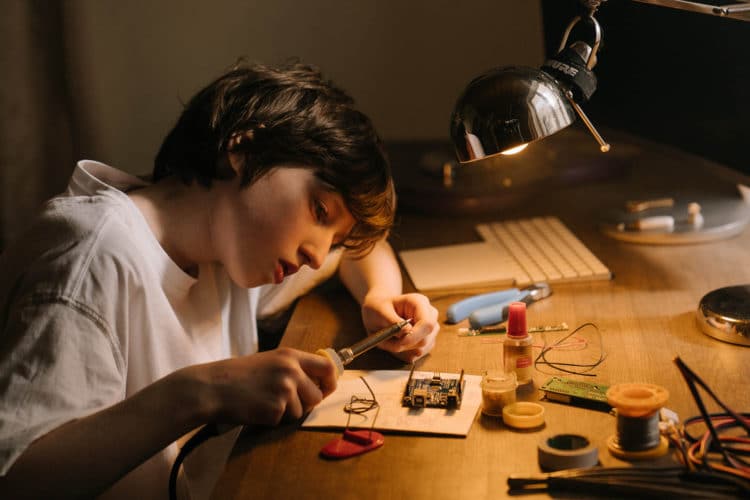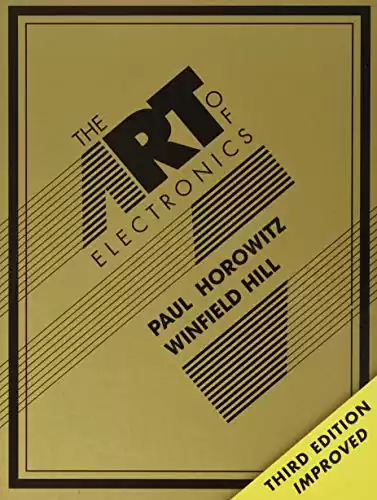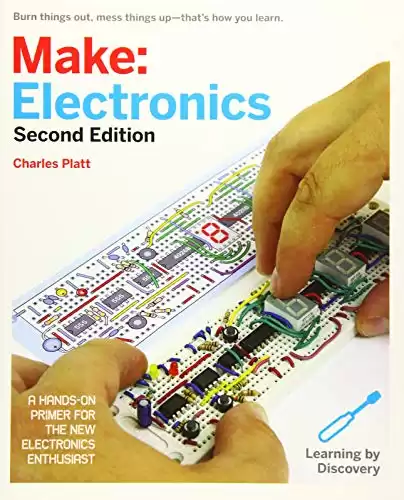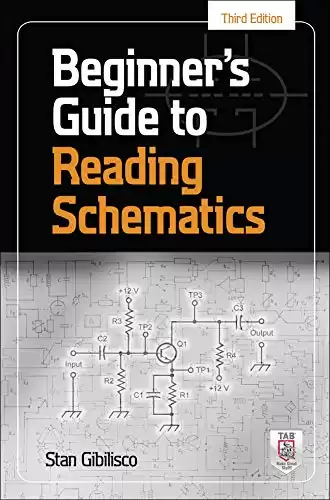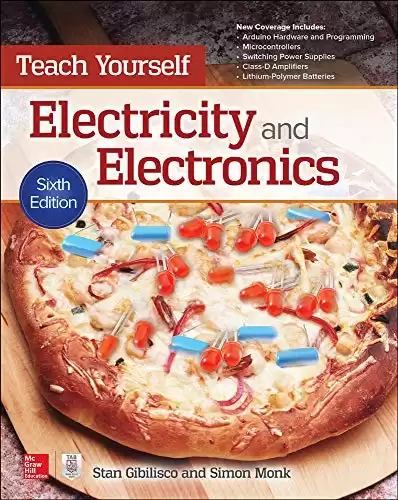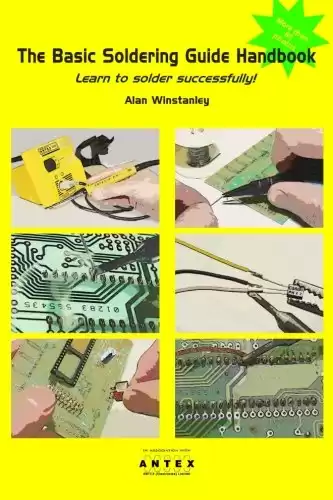For many self-learners, the high price of some textbooks in stores can be a rude awakening to their desire to learn or study in this field.
So, instead of buying a book only to find out that it’s not the right thing, have a look at the following list I’ve compiled for you. It contains a few of the best books out there on Electronics.
The main criterion of what made it into the list is not only the quality and accuracy of the content, but also how it’s presented.
One should have more than just one source of information on a subject. So, while you may select one book to start with, it should never be the be-all or end-all.
Pick one, make sure you finish it, then start the next one; That way, if there’s something, in particular, you didn’t understand, it can definitely help to get new insights from another resource.
While I’m mentioning the best books in this article, you might want to get other resources on top of what I mention here.
Best Books to Study and Learn Basic Electronics
Here’s a list of the best books to study and learn basic electronics:
- The Art of Electronics, 3rd Edition
- Make: Electronics: Learning Through Discovery
- Beginner’s Guide to Reading Schematics, 3rd Edition
- Teach Yourself Electricity and Electronics, 6th Edition
- The Basic Soldering Guide Handbook: Learn to Solder Electronics Successfully
- Electronics for Kids: Play With Simple Circuits and Experiment with Electricity!
1- The Art of Electronics, 3rd Edition
The Art of Electronics, 3rd Edition is a book written by Paul Horowitz and Winfield Hill. It is often referred to simply as “AOE”.
It’s arguably the most comprehensive, authoritative, and up-to-date text on electronics available.
The 3rd edition was published on April 9, 2015. In addition to corrections of errata from previous printings, this edition is extensively rewritten, and many new illustrations have been added.
The book has been praised for its balance between circuit theory and design practice, accuracy of presentation, clarity of exposition, and relevance to today’s electronics engineers.
It’s an update to the 2nd edition, which was released in 1989. The Art of Electronics contains information on all topics that are important to electronics engineers.
One thing that makes this textbook stand out from others is its amount of content; it’s filled with detailed descriptions, diagrams, tables, formulas, and circuit analysis techniques which make it very useful for both students and professional engineers.
It covers all topics relevant to electronic circuits, from basic principles, to cutting-edge applications in modern communication systems.
Additionally, there are chapters on specialized analog modules such as operational amplifiers, voltage regulators, and power supplies; digital techniques including both hardware and software state machines; a discussion of integrated circuit construction techniques that includes surface-mount part soldering, sequential and combinational logic; a detailed introduction to computers and interfacing for control applications, not to mention serial and parallel buses as well as data links, digital signal processing, and more.
I’ve always been torn between acquiring an electrical engineering education and a mechatronics one. I flipped a coin to assist me make my decision, which resulted in me picking the latter and receiving my BSME.
Recently graduated, I now have a job as a mechanical systems designer which I do enjoy, but I’m thinking about getting a master’s degree now that I’ve completed college and have had some practical experience.
I can continue doing what I’m already good at and get my MSME, or I may look for potentially greener pastures by pursuing an MSEE.
I concluded that I needed to work through a few books and really grasp the material, so I gave The Art of Electronics a go and haven’t regretted it. Check it out here.
2- Make: Electronics: Learning Through Discovery
This is a great book for beginner and intermediate electronics hobbyists. It has projects that range from very simple to medium difficulty, so it’s great for all levels.
If you have ever wanted to learn more about electronics but were intimidated by complex textbooks or just didn’t have enough time, then this is the perfect starting point!
The first chapter introduces you to tools and components needed for the projects, as well as basic electronic concepts which are used throughout the entire book.
The lists may look like a “wish list” but, if you use an alternate supplier for any components or supplies, make sure they meet the required specifications.
I was able to track everything down, and I think that, even if you’re not in the US, you should be able to find everything you need.
Electricity is a tricky subject to teach without a practical demonstration. The best way to learn about electricity is probably by tearing something apart and fixing it, and the author definitely took that into consideration, as there are plenty of pictures and diagrams which make it easy to follow along, but the best part is that you build everything yourself. If you like books with ‘hands-on’ projects, then this is just the one for you.
The projects are easy enough for beginners, yet interesting enough to hold the attention of more experienced hobbyists.
So, not only do you learn what something does but how it works as well. I think the author did a very good job at explaining things and presenting them in an accessible way — making electronics seem fun rather than intimidating.
Speaking of the author, Charles Platt, has also published works about electronics for Make magazine, and WIRED, in addition to having written many books on computers.
This is the perfect addition to The Art of Electronics, which I’ve mentioned earlier.
3- Beginner’s Guide to Reading Schematics, 3rd Edition
This book is ideal for anyone interested in learning how to read schematics.
The author does an excellent job of explaining the different symbols, components, and their uses. He’s also added clear diagrams that are easy to understand.
This is why I’d recommend it to anyone who wants to get started building small electronic devices such as AM/FM radios, LED signs, Alarms, etc…
This is not to say that there are no advanced projects in the book; don’t worry! The chapters get more interesting as you progress through.
The author also goes into depth about how different components work, but only to the point that is necessary for someone who wants to understand how an electronic circuit functions; i.e., he doesn’t go into extreme detail to the point where it becomes boring.
It feels like he makes no assumptions of previous knowledge, but starts from the beginning with fundamental circuit components, design principles, basic math for calculations, etc.
And what I like in particular is that he uses some common sense practical examples to make this learning process even more motivating. I’ve first heard about the book on the author, Stan Gibilisco’s YouTube channel, for those of you who want to check it out.
So, if you’re looking for an introductory book on how to read schematics – this should be your first choice!
I’m not going to spoil anything else – just check out the description on Amazon if you’re interested in finding out more!
4- Teach Yourself Electricity and Electronics, 6th Edition
This is another great book by Stan Gibilisco. The author is well known for his ability to explain electronics concepts from electronic principles, to devices, and circuits in a way that anyone can understand and apply them. Plus, if you’re already familiar with these subjects, it will be a great reference work for you too!
I particularly liked the section where the author explained schematic symbols. Then he described how each diagram represented a different circuit condition.
It was very helpful in “seeing” what an electronic circuit did by just looking at a picture of its symbolic representation.
The section on transistors also presented excellent, detailed information, and the author went into detail on biasing, amplification, as well as the difference between gain and frequency. And although it has been many years since I have studied bipolar junction transistor theory, the author’s explanations were just as clear today as they would have been back then.
The section on operational amplifiers covered linear and non-linear modes of operation, along with their respective circuits configurations. It was presented in a very easy-to-understand fashion, so I could see how each mode was different from the other.
Understanding this key concept is fundamental to mastering analog electronic circuit building blocks, and the best part is the quiz at the end of the IC section.
All in all, this is an easy-to-understand introduction to electricity and electronics that is mainly self-teaching with little math beyond arithmetic and basic algebra at the high school level; virtually no calculus or integration is necessary!
Its main topics are DC (direct current) circuit theory, AC (alternating current) circuit theory, transistor biasing and amplifier circuits, operational amplifier circuits, digital electronics, computer electronics, and no prior knowledge of electricity or electronics is assumed at all!
5- The Basic Soldering Guide Handbook: Learn to Solder Electronics Successfully
This electronics book covers basic electronic components, advanced soldering techniques, methods of making good solder connections, basic circuit construction techniques, and testing of the finished product.
Soldering is a skill that allows us to join electrical components together in a useful way.
The idea of soldering isn’t limited to electronics work. However, it may be used in any field where joining metal pieces is required.
Remember that you might not need to solder every time you build a circuit or project – there are many instances when glue or tape will do, but for more professional-looking results and for situations where greater strength and conductivity than can be provided by other methods is needed — soldering is the best option.
So, this is definitely a book that I was very pleased to find. It’s a good, solid reference for the beginner electronics hobbyist.
Right now, let me just review this as if you had no prior knowledge of soldering at all.
The book starts with a basic introduction to electricity and some rules-of-thumb useful for working with it wisely — this is fantastic.
If you’re new to soldering, there are some things that you may not know or think about yet, such as making the right soldering iron selection — what kinds are available, how to identify them, etc…
I know that when I first started, this stuff was not common knowledge. It’s so important to know these things, especially for beginners.
The author then switches gears into covering your workbench and equipment needs in some detail — very good advice here also! To ultimately get to the fun part, the step-by-step soldering process.
I’m not going to spoil it any further and will let you discover the rest on your own here.
All in all, this is my favorite soldering reference so far. I’ve been looking for a good soldering guide since the day I started getting my feet wet in electronics, and now I can finally say I found it.
In my opinion, this is the most complete and concise soldering manual on hobbyist level; the wording is extremely simple, without jargon most of the time. The illustrations are very clear and helpful; they cover almost everything described, so no need to worry about confusion.
It covers almost everything a hobbyist or an engineer will encounter whilst prototyping. Every time I thought of some trick that I knew and would not be in the book, there it was in the next paragraph.
The only reservation that I have is that the book does not deal with hand soldering surface mount components. It would be nice if the book could be revised to address that. But if someone learns from this book, the leap to hand soldered SMD (at least the SOIC types) should pose no real challenge for them.
Another minor issue I have with the book is that the author included safety precautions, and first-aid tips toward the end of the book, which in my opinion, should’ve been mentioned at the beginning.
6- Electronics for Kids: Play With Simple Circuits and Experiment With Electricity!
Learning electronics for kids doesn’t have to be complicated, but it can be fun! Through these simple projects with snap circuits, kids will learn how to build working electrical circuits, understand the relationship between electric current and everyday objects, and discover how some electronic devices work.
The book also includes a list of materials and a URL where you can find less expensive options for your shopping.
If you have younger children, I’d recommend helping them construct the circuits from this book together with you — it’ll be fun!
The projects in “Electronics for Kids” include:
- Using LEDs to produce light. The author also added a detailed resistor graph! This is great for teaching kids about resistance, colors that correspond to precise resistance values, and the color codes commonly used in resistors.
- An electric motor project which combines all of the concepts learned from other projects in the book: electricity, capacitors, inductors, and electromagnets! By building an electric motor with simple materials, kids will gain hands-on experience with electromagnets and learn how they can be used to make something extremely useful that should spark their interest in EE. This is one of my favorite projects in the book, period!
- Now, these are just two projects, but there’s enough to keep your child interested for days on end!
Aside from the numerous projects, one of the most impressive things about this book is that it includes information on different types of batteries, battery sizes, how to calculate power usage (with or without considering voltage), stress calculations using Ohm’s Law, capacitor calculations, inductor-coil calculations, transistor circuits…the list goes on!
All concepts are introduced gradually through fun hands-on projects — making sure that kids are able to relate these new concepts to what they already know.
The author provides a lot of great advice for parents who want to encourage their children’s interest in science and technology, so I’m looking forward to sharing all of it
Another thing I really appreciate is that this is not a dumbed-down version of a more advanced electronics book, i.e., it speaks directly to the kids and not down to them.
In fact, it will definitely challenge your kid while being interesting enough for adults to partake in the projects.
The illustrations are gorgeous and very cute. Though this book may be more of a ‘boy’ type book due to the robots theme, it can definitely catch girls’ attention too with the gorgeous illustrations and sci-fi theme, plus, it’s very well organized and also has a nice table of contents that I like to refer to when kids get stumped on one project and want to try something new.
Can You Learn Electronics on Your Own?
You can start by reading up on electrical current and simple circuits. Circuits are not necessarily complicated but usually consist of many interconnected electronic components, which can be arranged in infinite ways to meet different needs or desires. Examples of these components are resistors, capacitors, diodes, transistors, etc.
There are also several types of connectors and different power sources, such as a battery or a wall socket.
Electronics enthusiasts and experts will tell you: learning electronics requires knowledge and practice.
Of course, getting started in electronics isn’t too hard: there are plenty of books and online resources to help you understand the basics of how electronic components work together to control electricity; I’ve rounded up the best ones in this article.
Can I Get Started With Electronics Without Taking Courses or Buying Books?
You can easily learn enough to start creating simple devices by reading up on electricity and circuits online. However, reading alone will not give you the practical experience you need; thus, if you’re feeling particularly ambitious, creating a small project from the ground up is a good way to learn how real circuits function.
So, having someone to guide you might be the best way, and having some supporting materials with practical hands-on, step-by-step guides can be extremely valuable.
The good thing is that most of the books I’ve mentioned come with a purchase list and detailed instructions that will guide you every step of the way.
How Long Will It Take me to Learn Electronics?
As a rough estimate, expect to spend about 3 months on learning electronics if you read books and online resources. You should spend most of your learning time on creating your first circuit, that is at least a few weeks, depending on what level of expertise you want to achieve.
How Hard is it to Learn Electronics?
Electronics is very accessible: anyone who can read English should be able to use basic electronic components with relative ease after studying electricity and circuits. However, building larger projects for practical applications requires experience working with circuitry, which means designing real projects from the ground up using components purchased one at a time.
Do I Need a Specific Kind of Background to Start Learning Electronics?
You do not need to have a specific background in order to start learning electronics. Plus, there are plenty of resources that are easy for beginners to understand!
If you did not study electronics in your school days, or if you just want to brush up on the basics, you should definitely start with a good book like The Art of Electronics.
Understand some basic principles on how electricity works on a circuit, what components are used for, and why they function the way they do, can be super helpful, especially in the beginning.
Some knowledge of computer programming is helpful but not necessary. However, if you don’t have much prior knowledge in these subjects, it will likely take more time before you feel comfortable building any projects yourself.
Is Arduino a Good Way to Learn Electronics?
It’s true that hundreds of people have had success with this platform for hacking together electronic projects. But it also has some serious flaws. I don’t mean the hardware per se, but the whole approach to learning about electricity and circuits in general.
If you’re only using Arduino for your hackery, then you’ll probably never learn anything important or practically useful about how electrical systems work.
So, what are the issues with using an Arduino?
1) Unreliable High-Power Output
When you plug in an Arduino to drive a lightbulb or something, there are actually two separate circuits: One is the circuit that you hacked together, and the other is the Arduino board itself.
The output pin on the board is just a transistor with a very low current limit (and it’s not very efficient at all), so if you’re driving something that needs more than 40mA or so, then you’ll either need to use a more capable breakout board, or make some changes yourself. Probably not a huge deal by itself, but still…
2) Can’t Source/Sink Much Current
This relates directly to the first point about powering things from an Arduino. If you can drive a small load of ~40mA, then congratulations! You’ve likely maxed out your output capability.
To switch higher currents reliably, especially high-current LEDs (like car headlights), you will need either an external MOSFET or relay driver, or make some changes to the Arduino board itself.
3) Inherently Noisy
Pretty much every application of an Arduino involves using it to interface with another external device. But because the output pin is just a transistor inside a plastic box, there’s no consideration at all given to electrically isolating your circuit from whatever else is in your project.
That means if your other components are easily influenced by noise on the power line, then they could cause problems for your Arduino.
And since digital electronics notice even tiny amounts of “wrong” voltage, that also means you could have problems with seemingly benign environmental interference causing glitches and unexpected behavior in your device.
4) Limited General-Purpose Input/Outputs
Another thing that I see all the time on Instructables are beginner projects with an Arduino used for things it wasn’t really designed to do.
For example, I’ve seen people use it as a data logger or to control the speed of a motor.
Of course, you can always buy shields for these sorts of tasks, but if you use one, you’ll have less room for your own hacks.
5) Restricted Hardware Choices
Because the board is so popular, certain parts may be hard to find or expensive because they’re either sold out or incompatible with other platforms. And just because something exists in the form of a breakout board, doesn’t mean you can plug it into an Arduino without changing any hardware wiring.
For example, this project is popular, but the board only works with pinMode (INPUT), so you can either use a different microcontroller, or if you want to stick with Arduino, then you’ll need to reverse-engineer and potentially modify some hardware.
Nowhere near all of these problems are “Arduino’s fault”; it’s just that most things made for beginners don’t consider EMC at all when they’re soldering everything together.
So, if using an Arduino actually made it easier for beginners, then that would defeat the purpose of making products that help people learn!
Fortunately, there are alternatives such as mbed and Launchpad, which do avoid many of the common beginner mistakes.
They also have most of the advantages that Arduino has, so they’re just better starting points in general.
So, there you have it. I think everyone should be able to understand this topic well enough to critically review their own projects and decide whether or not the issues I noted are relevant for what they are trying to accomplish, but the bottom line is, nothing replaces a good book, with clear, concise instructions.
And if you need help with designing your project, then feel free to post a comment below! I hope this article was helpful.
